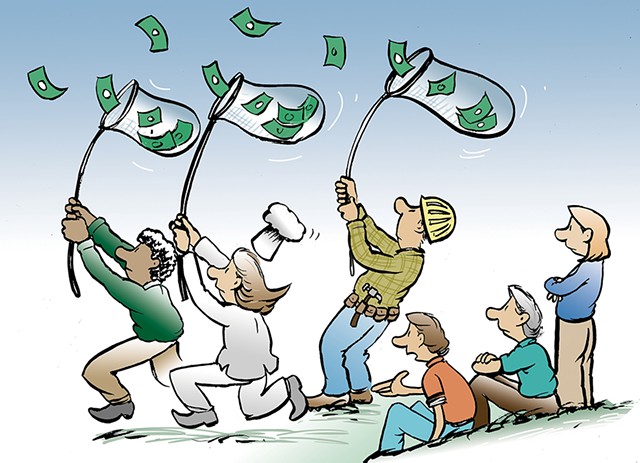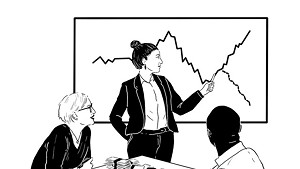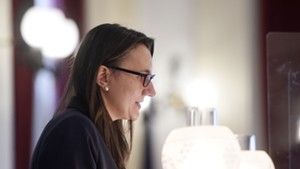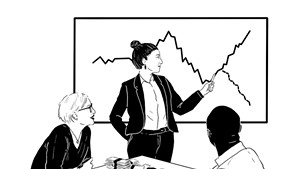Current state workers would pay more toward the ballooning cost of their pensions and receive less generous benefits in retirement under a proposal put forward by House leadership Wednesday and immediately blasted by union leaders.
The package of reforms presented in the House Government Operations Committee attempts to confront a pension crisis that has deepened with the revelation in the fall that the state system is $600 million worse off than previously revealed.
“Nobody likes the situation we’re in,” Rep. Sarah Copeland Hanzas (D-Bradford) told her colleagues as she presented the preliminary plan. “But we are looking to try to find the right combination of changes that will make this more sustainable for the General Fund as well as for the retirees and beneficiaries.”
Union officials unloaded on the plan, saying it has not been crafted transparently, unfairly burdens workers and represents a failure of leadership to tackle the problem collaboratively.
"The reason that Vermont has done so well in this pandemic is because of the sacrifices and expertise and hard work of our members, and the reward for that is we’re going to stick it to you in retirement," said Steve Howard, executive director of the Vermont State Employees' Association.
The $600 million increase in liabilities stems largely from a revision of the assumed investment return — which the state has fallen short of for years — from its current 7.5 percent to 7 percent.
The drop means others sources of revenue are needed to make up the difference. The increase widened the gap between how much money is coming into state’s various pension funds and how much they will have to pay out over time — known as the unfunded liability — to a staggering $3 billion. Estimates are even higher when retirees' health care is considered.
The gulf is so large and growing so fast that no single solution is going to solve the problem anytime soon, Chris Rupe, a financial analyst with the legislature’s Joint Fiscal Office, told lawmakers .
“Charting any proposed path forward would likely require multiple options and some painful and difficult trade-offs for both members and the state,” Rupe said.
For workers, those trade-offs would clearly fall on the shoulders of existing state employees, not retirees. That was one of the core principles of House leadership’s approach to solving the problem, Copeland Hanzas said.
House Speaker Jill Krowinski (D-Burlington) pledged as much in a recent open letter when she reassured “current retirees and those close to retirement” that they “do not need to panic and worry that their retirement plans are in jeopardy.”
The plan would not touch the benefits or future cost-of-living increases for the current 17,300 retired state workers and teachers drawing benefits. But it would increase the contributions of most of the 18,500 current state employees paying into the system while also pushing back their retirement age and trimming benefits.
If all proposed measures are approved, estimates say they would reduce the unfunded liability in the system by about $518 million over time. They would also reduce by about $80 million the projected increase in annual state payments to the funds. Without the changes, state contributions are currently projected to rise $96 million next year, to $316 million.
The contribution increases and benefit reductions are numerous and complicated. They include increasing the percentage of salary that employees pay. Most state employees' contributions would increase from 6.65 percent to 7.75, a 1.1 percent increase. Teachers, whose fund is in more trouble, would face a steeper increase. They pay 5 to 6 percent now, but would pay 7.25 percent under the plan. In that scenario, a teacher making $50,000 and paying 5 percent now would pay $1,125 more per year toward their retirement.
If investment returns for the funds fall short, higher-paid employees would pay progressively more. For example, employees earning up to $40,000 would pay 0.25 percent more. Earnings over $100,000 would be tapped for an additional 1.25 percent. The changes aim to ensure employees share the risks in the event of poor investment performance.
The plan would apply cost-of-living increases for future retirees only to the first $24,000 of income and only after the retiree hits age 67. If the health of the fund improves from their current distressed levels, the increases would be applied to more income.
The plan calls for calculating pensions based on an average of employees’ top seven salary years instead of the top 3 years. The change is meant to smooth out spikes in salary that sometimes occur at the end of employees’ careers. The plan would also require employees to work for 10 years before they can become eligible for — or vested in — a pension. Currently, employees are vested after five years.
The plan would eliminate some early retirement options, including one that allows some public safety officers to retire at age 50 with 20 years of service. It would reducing the cap on some pensions from 100 percent of salary to 60 percent, with increases beyond that of 1 percent for every year of service past 18.
To boost pension assets , lawmakers are also proposing a one-time infusion of an additional $150 million made possible by federal COVID-19 relief funds.
In January, Vermont Treasurer Beth Pearce, a strong supporter of the state's defined-benefit pension plan model, said "extraordinarily painful" cuts would be required to keep the system solvent. Many of her ideas were incorporated into the House's plan.
Howard said the proposed plan was crafted "in secret," but he also acknowledged that union officials have spoken with Krowinski's office weekly throughout the session on this issue. He said the meetings were brief "temperature checks" and not the kind of detailed negotiations he would have preferred.
Seeing the writing on the wall, public sectors unions came out strongly against the direction of the reforms even before they were announced. Aimee Bertrand Towne, president of the 6,000-member-strong Vermont State Employees' Association, proposed a way to solve the pension crisis “without the devastating cuts to state employees” in a March 18 letter to Krowinski.
She urged the speaker to tax the rich to pay for the shortfalls with a “temporary surcharge” on households making more than $500,000 annually. She also proposed using federal funds to bridge the gap and to establish a study committee to examine the issue further.
In addition to the contribution and benefit changes, the proposal would restructure and consolidate the separate boards that manage the state pension funds into a single 15-member Vermont Retirement Commission.
Howard said he's baffled by Krowinski's apparent desire to "ram this through" before the end of the legislative session instead of taking the summer to conduct a more thorough review of the issues and possible solutions.
"There's $5 billion in the fund. It’s not going to collapse tomorrow," Howard said.
Instead, lawmakers dropped the proposal on a Wednesday and
scheduled a public hearing just two days off, on Friday from 4 p.m. to 6 p.m. Because of the intense interest, a second hearing is being scheduled for the following Monday, Howard said.














Comments
Comments are closed.
From 2014-2020, Seven Days allowed readers to comment on all stories posted on our website. While we've appreciated the suggestions and insights, right now Seven Days is prioritizing our core mission — producing high-quality, responsible local journalism — over moderating online debates between readers.
To criticize, correct or praise our reporting, please send us a letter to the editor or send us a tip. We’ll check it out and report the results.
Online comments may return when we have better tech tools for managing them. Thanks for reading.